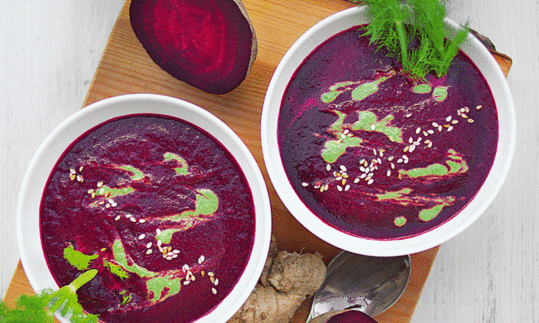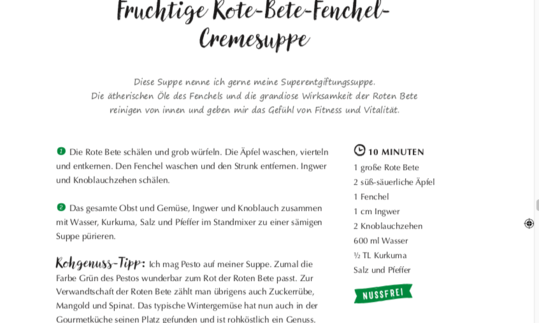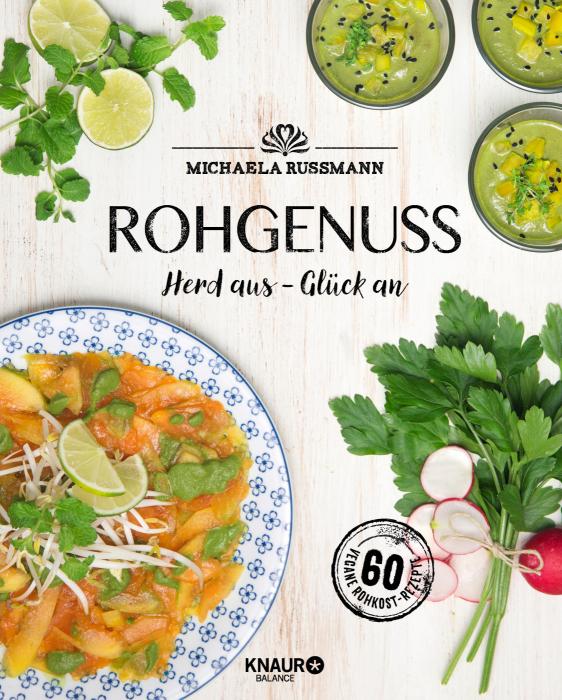Fruity beetroot and fennel cream soup with apple and turmeri
raw-vegan
Ingredients (for servings, )
| 1 large | Beetroot, raw (organic?) (9.0 oz) |
| 2 | Apples Gala, raw (organic?) (12 oz) |
| 1 | Fennel (bulb, raw, organic?) (10 oz) |
| 1 cm | Ginger, raw (organic?) (0.38 oz) |
| 2 cloves | Garlic (organic?) (0.21 oz) |
| 600 ml | Drinking water, raw (organic?) (21 oz) |
| ½ tsp | Turmeric (saffron root), ground, raw (organic?) (0.05 oz) |
| 1 dash | Table salt (table salt, raw?, organic?) (0.01 oz) |
| 1 dash | Black pepper (organic?, raw?) (0.00 oz) |
Equipment
- blender
- vegetable peeler
Type of preparation
- chop or grind
- food preparation without heating
- purée
- remove the skin
- peel
Preparation
Preparation
Peel the beetroot and roughly dice. Wash, quarter and core the apples. Wash the fennel and remove the stalk. Peel the ginger and garlic cloves.The author recommends using sweet and sour apples. Other examples are Braeburn, Cox Orange or Elstar.
preparation
Puree all the fruit and vegetables, ginger and garlic together with water, turmeric, salt and pepper in a blender until you have a creamy soup.Author's tip: A little green pesto on the soup tastes good and looks wonderful in contrast to the red of the beetroot.
|
Nutritional Information per person
Convert per 100g
|
2000 kcal | |
|---|---|---|
| Energy | 104 kcal | 5.2% |
| Fat/Lipids | 0.40 g | 0.6% |
| Saturated Fats | 0.10 g | 0.5% |
| Carbohydrates (inc.dietary fiber) | 24 g | 9.0% |
| Sugars | 16 g | 17.9% |
| Fiber | 6.2 g | 24.6% |
| Protein/Albumin | 2.3 g | 4.6% |
| Cooking Salt (Na:133.2 mg) | 338 mg | 14.1% |
| Essential micronutrients with the highest proportions | per person | 2000 kcal | |
|---|---|---|---|
| Vit | Vitamin K | 46 µg | 62.0% |
| Vit | Vitamin B9, B11 (Folate, as the active form of folic acid) | 92 µg | 46.0% |
| Elem | Potassium, K | 621 mg | 31.0% |
| Min | Manganese, Mn | 0.49 mg | 24.0% |
| Vit | Vitamin C (ascorbic acid) | 19 mg | 24.0% |
| Sodium, Na | 133 mg | 17.0% | |
| Min | Copper, Cu | 0.14 mg | 14.0% |
| Elem | Phosphorus, P | 75 mg | 11.0% |
| Min | Iron, Fe | 1.4 mg | 10.0% |
| Vit | Vitamin B6 (pyridoxine) | 0.14 mg | 10.0% |
Detailed Nutritional Information per Person for this Recipe
The majority of the nutritional information comes from the USDA (US Department of Agriculture). This means that the information for natural products is often incomplete or only given within broader categories, whereas in most cases products made from these have more complete information displayed.
If we take flaxseed, for example, the important essential amino acid ALA (omega-3) is only included in an overarching category whereas for flaxseed oil ALA is listed specifically. In time, we will be able to change this, but it will require a lot of work. An “i” appears behind ingredients that have been adjusted and an explanation appears when you hover over this symbol.
For Erb Muesli, the original calculations resulted in 48 % of the daily requirement of ALA — but with the correction, we see that the muesli actually covers >100 % of the necessary recommendation for the omega-3 fatty acid ALA. Our goal is to eventually be able to compare the nutritional value of our recipes with those that are used in conventional western lifestyles.
| Essential fatty acids | per person | 2000 kcal |
|---|---|---|
| Linoleic acid; LA; 18:2 omega-6 | 0.16 g | 2.0% |
| Alpha-Linolenic acid; ALA; 18:3 omega-3 | 0.00 g | < 0.1% |
| Essential amino acids | per person | 2000 kcal |
|---|---|---|
| Tryptophan (Trp, W) | 0.01 g | 6.0% |
| Threonine (Thr, T, irreversibly transaminated) | 0.04 g | 4.0% |
| Isoleucine (Ile, I) | 0.04 g | 3.0% |
| Valin (Val, V) | 0.04 g | 3.0% |
| Leucine (Leu, L) | 0.05 g | 2.0% |
| Lysine (Lys, K, irreversibly transaminated) | 0.04 g | 2.0% |
| Methionine (Met, M) | 0.01 g | 2.0% |
| Phenylalanine (Phe, F) | 0.04 g | 2.0% |
| Vitamins | per person | 2000 kcal |
|---|---|---|
| Vitamin K | 46 µg | 62.0% |
| Vitamin B9, B11 (Folate, as the active form of folic acid) | 92 µg | 46.0% |
| Vitamin C (ascorbic acid) | 19 mg | 24.0% |
| Vitamin B6 (pyridoxine) | 0.14 mg | 10.0% |
| Vitamin B2 (Riboflavin) | 0.08 mg | 5.0% |
| Vitamin B3 (Niacin) | 0.77 mg | 5.0% |
| Vitamin B5 (Pantothenic acid) | 0.33 mg | 5.0% |
| Vitamin A, as RAE | 36 µg | 5.0% |
| Vitamin E, as a-TEs | 0.62 mg | 5.0% |
| Vitamin B1 (Thiamine) | 0.04 mg | 4.0% |
| Vitamin B7 (Biotin, ex vitamin H) | 0.02 µg | < 0.1% |
| Essential macroelements (macronutrients) | per person | 2000 kcal |
|---|---|---|
| Potassium, K | 621 mg | 31.0% |
| Sodium, Na | 133 mg | 17.0% |
| Phosphorus, P | 75 mg | 11.0% |
| Magnesium, Mg | 35 mg | 9.0% |
| Calcium, Ca | 60 mg | 7.0% |
| Essential trace elements (micronutrients) | per person | 2000 kcal |
|---|---|---|
| Manganese, Mn | 0.49 mg | 24.0% |
| Copper, Cu | 0.14 mg | 14.0% |
| Iron, Fe | 1.4 mg | 10.0% |
| Zinc, Zn | 0.47 mg | 5.0% |
| Fluorine, F | 108 µg | 3.0% |
| Selenium, Se | 1.2 µg | 2.0% |
| Iod, I (Jod, J) | 0.18 µg | < 0.1% |
Verlagsgruppe Droemer Knaur GmbH & Co. KG, Michaela Russmann
Raw recipes 54 (4), Cooked recipes 8
Additional photos (6)
The book "Raw Delight – Stove Off – Happiness On" contains creative and mostly healthy, everyday, raw vegan recipes by Michaela Russmann.
Since this book is written in German, a description is omitted here. If you are interested, please switch to German in the menu.
The apple gives the beetroot and fennel cream soup with turmeric and ginger a fruity note. Simple, delicious and quick to prepare.
Nutrient profile: According to GDA guidelines, one portion of this dish covers around 60% of the average daily requirement of potassium and 45% of that of folic acid. With 114 kcal per portion, the soup is extremely low in calories, but fortunately contains a high fiber content.
You can find helpful information about recommended nutrient compositions and easily avoidable mistakes in a vegan diet at the following link: Vegans often eat unhealthily. Avoidable nutritional mistakes.
Beetroot: Beetroot, also called rande, belongs to the Amaranthaceae family. The characteristic red color is mainly due to the high concentration of the glycoside betanin from the group of betalains. Due to its high content of vitamin B, potassium, iron and folic acid, beetroot is a healthy vegetable that can be used cooked or raw in salads. People who are prone to the formation of kidney stones, e.g. Crohn's disease patients, should only eat beetroot in moderation due to the high oxalic acid content.
Fennel: Bulb and seeds of the fennel plant native to the Mediterranean and Asia Minor are used as ingredients in both raw and cooked dishes. Like celery, fennel belongs to the Umbelliferae family. The white to light green bulb is layered, similar to an onion, and has an intense aroma, which it owes to its high content of essential oils. The essential oils are also responsible for the health properties - such as aiding digestion. The green stems of the bulb are covered with dill-like fennel greens.
Ginger: Ginger has an aromatic smell and a sharp, spicy taste, which is due to the (spicy) substance gingerol, which is said to have anti-carcinogenic and anti-inflammatory effects. The substances borneol and cineol give ginger its digestive, antiemetic, appetite-stimulating and circulation-stimulating properties. The ginger rhizome is used in cooking in fresh, dried or ground form. Green or young ginger refers to the young harvested rhizomes, which have a milder taste and whose consistency is not yet as woody as that of a mature rhizome.
Turmeric: Turmeric, also known as yellow ginger or turmeric root, comes from South Asia and belongs to the ginger family. Fresh turmeric has a resinous, slightly burning taste; dried, as is often used in India, it tastes milder and slightly bitter. Turmeric is best stored in a dark place and not for too long, as otherwise the color and aroma will be lost.
Michaela Russmann on beetroot: The taste of beetroot is a little bitter with a subtle earthy aroma in the finish. The yellow or white beetroot varieties are a little sweeter. The beets are also available pickled or already cooked and vacuum packed in the supermarket. However, it is much tastier and of course healthier to use them fresh in raw form. Beetroot can develop its full flavour in freshly squeezed juices, as part of a smoothie, as a salad or in a delicious raw food soup. Its wonderful colour supports the aspect that the eye likes to eat too.
Fresh turmeric: You can use fresh turmeric instead of turmeric powder. Then grate or grate it finely. It is best to use gloves for this, as turmeric is very intensely colored. This can cause permanent discoloration, especially on white kitchen appliances.






